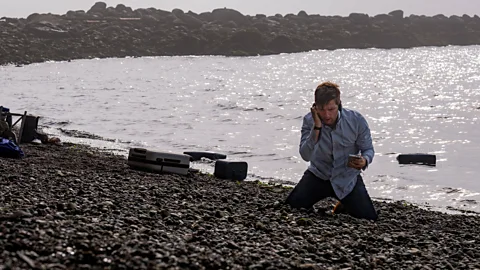The Twilight Zone: ‘Eerie, witty, stylishly told stories’
 Robert Falconer/CBS
Robert Falconer/CBSGet Out and Us director Jordan Peele reboots cult classic The Twilight Zone, which premieres with two strong episodes, writes Caryn James.
It’s possible that, in some distant twilight zone, Rod Serling and Jordan Peele switched places. More likely, Peele is the ideal person to adapt Serling’s classic show. As co-creator and on-screen host of the new version, he updates the series while capturing the original’s essence. Ordinary people are trapped in living nightmares only they can see: a stand-up comedian’s routine gives him alarming power over life or death; a traveller gets a supernatural warning, mid-flight, that his plane is doomed.
Few TV programmes have had the enduring cultural impact of The Twilight Zone, whose very name is now shorthand for being in a bizarre, irrational situation. The original, which began in 1959, has been a clear influence on Peele’s socially-relevant horror films, from the psychological underworld of the ‘sunken place’ in Get Out to the evil doppelgangers in his current hit Us. That influence comes full circle in the series, which is more homage than remake. Peele does not direct these episodes, but his presence is everywhere in the eerie, witty, stylishly told stories, which come with sharp social commentary.
More like this:
The new version borrows the anthology format of the original, with an ever-changing cast of well-known actors. Peele (who created the series with Simon Kinberg, producer of the X-Men films) even echoes Serling’s appearances, turning up in a suit and tie at the beginning and end of each episode. With a straight face, Peele delivers lines full of deliberately cringe-worthy word play. In the aeroplane episode, he says, “Landing on the truth this time will require an unscheduled stop in…” dramatic mini-pause “…the Twilight Zone.” Too much of that would have been kitschy, but those winking nods to the original are used just enough to create a wry, tongue-in-cheek effect.
The series premieres with two strong episodes, with more dropping weekly. In The Comedian, Kumail Nanjiani (The Big Sick) once again proves what a subtle actor he can be. He plays a struggling comedian (Samir) who gets advice from a well-known comic (Tracy Morgan). If Faust were a stand-up, this would be his story, as dark consequences accompany Samir’s growing success. The plot is clever, but the real point is the character’s psychology as it taps into celebrity culture. How much will he sacrifice to fame?
Peele’s show isn’t as dark as Black Mirror, another series heavily under the influence of the original Twilight Zone. Like his films, these episodes have a playful tone, and are laced with pop-culture references. The last image in The Comedian is a reference to The Shining, and future episodes include allusions as far apart as the TV series Lost and the 1940s and 1950s actress-director Ida Lupino.
The other episode premiering this week is Nightmare at 30,000 Feet, a direct homage to the classic episode, Nightmare at 20,000 Feet, starring William Shatner as a man who sees a monster on the wing of his plane. The updated version has a much more sophisticated plot. Adam Scott plays a journalist with PTSD, whose premonition of disaster comes by way of a podcast only he hears, a voice from the future predicting what’s about to happen.
Playing with time is one of the new Twilight Zone’s favourite, most effective strategies, allowing it to toy with ideas about society and free will. In a future episode, Sanaa Lathan’s character can return to the past by rewinding her old-fashioned camcorder. It doesn’t ruin the suspense to say that this episode is also pointedly about Black Lives Matter and racial profiling. While the story curves and teases, it emphasises how intractable racism is.
All these characters try to control their futures, but in the end Peele returns to the screen to find them in the same unnerving state. They have learned that even magical powers can’t avert fate.
If you would like to comment on this story or anything else you have seen on BBC Culture, head over to our Facebook page or message us on Twitter.
And if you liked this story, sign up for the weekly bbc.com features newsletter, called “If You Only Read 6 Things This Week”. A handpicked selection of stories from BBC Future, Earth, Culture, Capital and Travel, delivered to your inbox every Friday.
